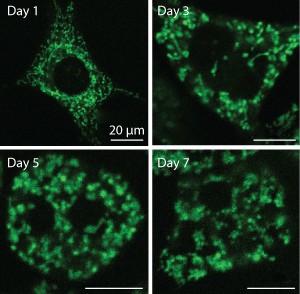

The fluorescent probe AIE-MitoGreen-1 reveals changes in mitochondrial organization in brown adipose cells as they mature over the course of a week.
Reproduced, with permission, from Ref. 1 © 2014 Royal Society of Chemistry
A new cellular labeling strategy gives researchers an efficient tool for studying the development of tissue that could help prevent the onset of obesity and cardiovascular disease [1].
Most people think about fat in terms of the white adipose tissue that stores the body’s excess energy, and which steadily — and visibly — accumulates as one becomes out of shape or obese. However, there is another type of fat tissue that can prevent rather than promote weight gain.
“Brown adipose tissue not only stores fats, but also has the ability to burn fats to release energy as heat,” explains Bin Liu of the A*STAR Institute of Materials Research and Engineering.
Liu sees this tissue as a promising target for anti-obesity drugs, and her group set about designing a fluorescent molecule that could help scientists visualize the development of brown adipose cells. These cells can be characterized based on the number and organization of their mitochondria, the organelles that drive cellular metabolism.
However, existing mitochondrial dyes tend to absorb each other’s fluorescence at high concentrations, resulting in a weaker overall signal as they accumulate.
In collaboration with Hong Kong University of Science and Technology researcher Ben Zhong Tang, Liu’s team devised a fluorescent dye that exhibits ‘aggregation-induced emission’. “This means that the probe does not emit fluorescence in dilute solutions,” explains Liu, “but it becomes highly fluorescent when it accumulates in mitochondria, without any self-quenching effects.”
After 20 minutes of treatment with their AIE-MitoGreen-1 probe, Liu’s group achieved bright labeling of mitochondria in brown adipose cells that lasted for more than a day. This labeling approach also left cultured cells largely unharmed, whereas only 10 per cent of cells survived prolonged treatment with a commercially available mitochondrial dye. The researchers subsequently used AIE-MitoGreen-1 to monitor the development of brown adipose tissue from precursor cells, observing changes in cell shape and mitochondrial organization over seven days (see image).
Since the basic stages of brown adipose development are well characterized, this probe could help identify treatments that stimulate or impede this process. “We hope to use our probe to monitor the activity of brown adipose cells in response to various stimuli, such as drug intervention or temperature changes,” says Liu. Her group aims to further improve their probe so that it shines longer and brighter. Ultimately, she hopes to develop variants that fluoresce at near-infrared wavelengths, which can be detected deeper within living tissue. “We would apply these probes to long-term monitoring of brown adipose cells in animal models.”
Reference
[1] Gao, M., Sim, C. K., Leung, C. W. T., Hu, Q., Feng, G. et al. A fluorescent light-up probe with AIE characteristics for specific mitochondrial imaging to identify differentiating brown adipose cells. Chemical Communications 50, 8312–8315 (2014).
Associated links
A*STAR article















